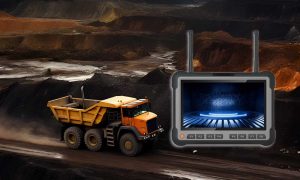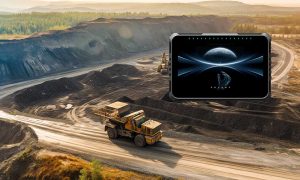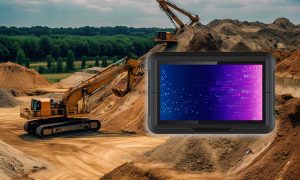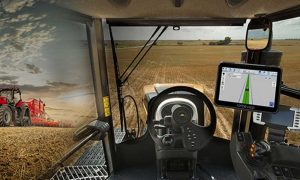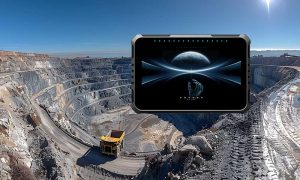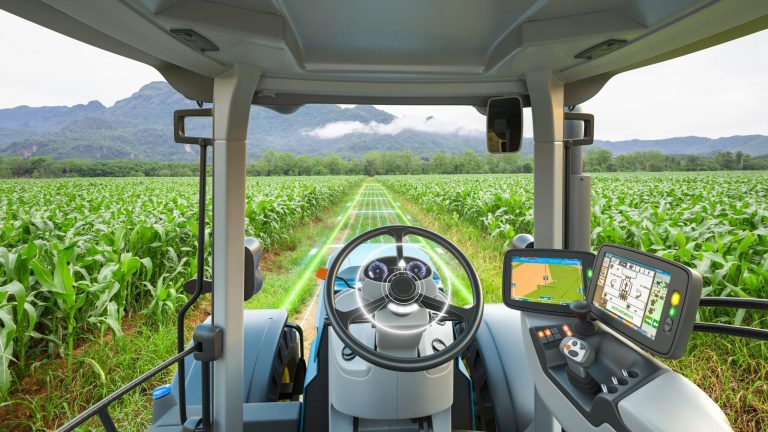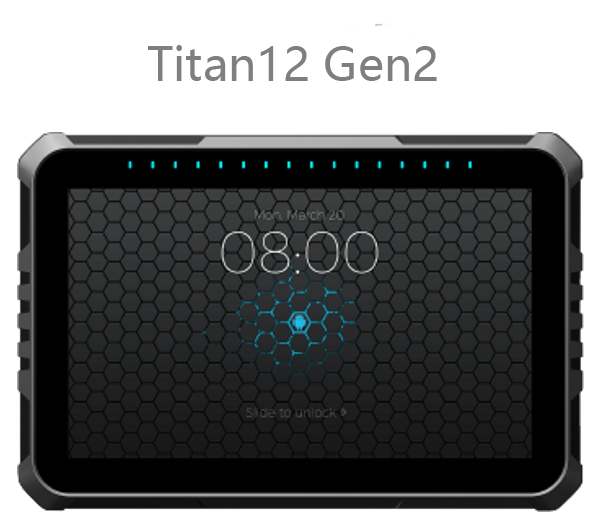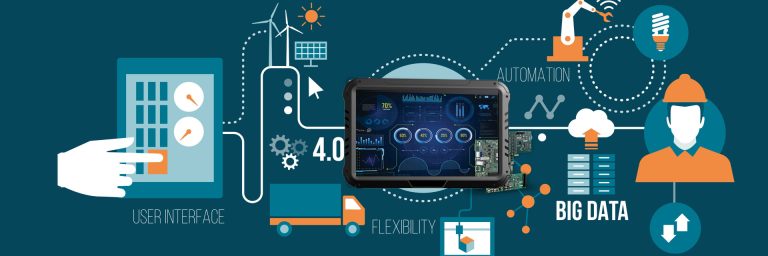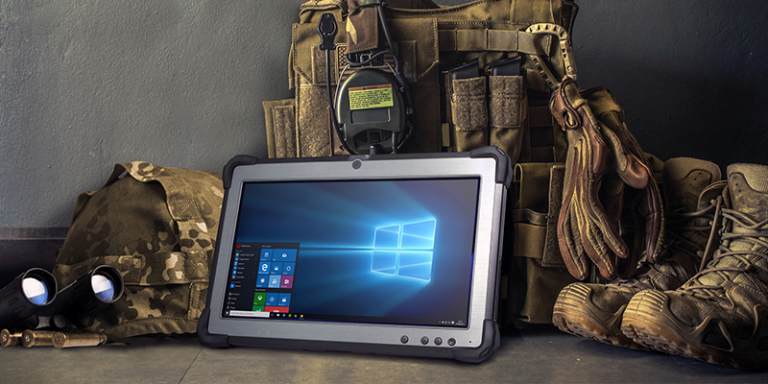In the demanding environments of mining operations, technology plays a crucial role in streamlining processes, improving efficiency, and enhancing safety. One such indispensable tool is the mining tablet, a ruggedized device that is designed to withstand harsh conditions while providing critical data access to field workers, supervisors, and managers. However, one of the most important factors that can make or break the usability of a mining tablet is its screen visibility, particularly under extreme lighting conditions, such as direct sunlight or low-light environments.
In the mining industry, workers often operate in outdoor settings, where they are exposed to direct sunlight, or underground, where lighting is minimal or entirely absent. A mining tablet that cannot display data clearly in these lighting conditions can severely hinder productivity, lead to errors, and even compromise safety. In this article, we will explore how screen visibility impacts the effectiveness of mining tablets, what factors influence readability in various lighting environments, and the key technologies and features that ensure that mining tablets remain visible and usable, regardless of lighting conditions.
The Importance of Screen Visibility in Mining Tablets
Mining operations often span vast, open areas, underground tunnels, or remote locations where conditions are far from ideal for using electronic devices. Workers need to access critical data on their mining tablet in real-time, whether it’s monitoring machinery performance, checking safety parameters, or communicating with their team. If the tablet’s screen is not easily readable due to glare from the sun or insufficient lighting, the efficiency and accuracy of these tasks can be compromised.
Here are several reasons why clear screen visibility is essential for a mining tablet:
1. Real-Time Data Access
Mining workers need immediate access to data, including geological information, equipment diagnostics, inventory levels, and safety alerts. A mining tablet that struggles with screen visibility can delay crucial decisions and actions. Whether in a dark underground mine or under bright sunlight, workers must be able to view and interact with the data on their tablets without straining their eyes or wasting time adjusting the screen.
2. Safety Considerations
In mining, safety is paramount. Workers often rely on their mining tablets to receive real-time safety alerts, monitor environmental conditions, and follow safety protocols. Poor screen visibility can prevent workers from receiving timely information, increasing the risk of accidents or hazards going unnoticed. For instance, a worker may miss an alert about a gas leak if they cannot see the tablet’s screen clearly in low-light conditions.

3. Reducing Errors
Accurate data input and output are essential in mining operations. A tablet that cannot display data clearly increases the likelihood of input errors, which can result in miscalculations, incorrect decisions, or missed deadlines. Whether workers are entering information about ore extraction, recording fuel levels, or updating production schedules, clear visibility of the mining tablet screen ensures that errors are minimized.
4. Enhanced Productivity
When workers can easily view their mining tablet screens regardless of lighting conditions, they can complete tasks more efficiently. This improved workflow boosts overall productivity by eliminating delays caused by poor visibility. Workers won’t need to waste time finding shaded areas to read their tablets or repeatedly adjusting the screen brightness to accommodate changing lighting conditions.
Factors Affecting Screen Visibility in Mining Tablets
Several factors influence the visibility of a mining tablet in direct sunlight or low-light environments. These include screen brightness, anti-glare technology, screen resolution, contrast ratio, and color accuracy. Understanding how each of these factors contributes to visibility can help mining companies choose the right mining tablet for their needs.
1. Screen Brightness
Screen brightness is one of the most critical factors that determine how easily a tablet’s display can be read in direct sunlight. Brightness is measured in nits (candelas per square meter), and the higher the number of nits, the brighter the screen. Standard consumer tablets typically have brightness levels between 300 and 500 nits, which may not be sufficient for outdoor mining environments with intense sunlight.
For a mining tablet to be clearly visible in direct sunlight, it should have a brightness level of at least 800 nits. Some high-end rugged tablets designed for outdoor use can even reach brightness levels of 1000 to 1500 nits, making them ideal for environments where sunlight is a constant factor.
2. Anti-Glare and Anti-Reflective Coatings
In addition to brightness, glare is a major issue when using tablets outdoors. Glare occurs when sunlight or artificial light reflects off the screen, making it difficult to see the display. Mining tablets often come equipped with anti-glare or anti-reflective coatings that reduce the amount of light reflected from the screen’s surface.
Anti-glare coatings diffuse light, making the screen easier to read in bright conditions. Anti-reflective coatings, on the other hand, reduce the intensity of reflections. Both technologies work in tandem to improve screen visibility in direct sunlight. For mining workers operating in open-pit mines or other outdoor locations, a mining tablet with these coatings is essential to ensuring that critical information remains legible.
3. High-Resolution Displays
Screen resolution refers to the number of pixels that make up the display. A higher resolution means sharper, clearer images, which is particularly important when workers need to view detailed maps, schematics, or charts on their mining tablets. High-resolution displays enhance visibility by making text and images more defined, even when viewed in less-than-ideal lighting conditions.

4. Contrast Ratio
The contrast ratio of a display measures the difference between the darkest black and the brightest white the screen can produce. A higher contrast ratio results in better differentiation between colors and shades, which is crucial in low-light environments where subtle variations in color can be hard to see.
For mining tablets, a high contrast ratio is particularly useful when working in underground mines or dimly lit environments. Tablets with high contrast ratios ensure that workers can clearly see critical information, even when ambient lighting is poor. This improves safety and accuracy when workers are relying on their tablets to navigate or monitor equipment.
5. Color Accuracy and Saturation
While color accuracy may not seem as important as brightness or resolution, it plays a significant role in screen visibility, especially when viewing charts, graphs, or color-coded information. A mining tablet with good color accuracy ensures that colors are displayed as intended, reducing the risk of misinterpretation. For instance, a safety alert that appears in red on the screen must be easily distinguishable from other elements to grab the worker’s attention.
Color saturation, or the intensity of colors, also affects visibility. A tablet with well-calibrated color saturation will display vivid, easy-to-read colors, even in challenging lighting conditions.
Key Features for Optimized Screen Visibility in Mining Tablets
To ensure that mining tablets are usable in both direct sunlight and low-light environments, manufacturers incorporate a range of features specifically designed to enhance screen visibility. Below are some of the key features to look for when selecting a mining tablet for optimal screen visibility:
1. Sunlight-Readable Displays
Sunlight-readable displays are designed to provide clear visibility in bright outdoor environments. These displays use a combination of high brightness levels (800+ nits), anti-glare coatings, and enhanced contrast ratios to ensure that the screen remains readable even in direct sunlight. Many mining tablets are equipped with sunlight-readable displays, making them ideal for workers in open-pit mines or other outdoor locations.
2. Backlit Keyboards and Controls
For workers who operate in low-light or underground environments, a mining tablet with a backlit keyboard or backlit physical controls can be extremely helpful. Backlighting ensures that workers can easily see and operate the tablet even in complete darkness, enhancing usability and reducing the risk of input errors.
3. Ambient Light Sensors
Some mining tablets come equipped with ambient light sensors that automatically adjust the screen brightness based on the surrounding light conditions. These sensors detect changes in lighting and increase or decrease the brightness accordingly, optimizing screen visibility without requiring the worker to manually adjust the settings. This feature is particularly useful for workers who move between areas of varying light, such as from bright outdoor areas to dark tunnels.
4. Adjustable Brightness Settings
While automatic brightness adjustment is convenient, some workers may prefer to manually control the brightness of their tablet screens. Mining tablets typically offer a range of adjustable brightness settings, allowing workers to tailor the screen to their specific needs. This flexibility ensures that the screen remains visible regardless of the lighting conditions.
5. Polarized Screen Filters
For workers who wear polarized sunglasses, seeing the screen of a tablet can sometimes be challenging due to the way light interacts with the display. Polarized screen filters on mining tablets help mitigate this issue by reducing the distortion caused by polarized lenses, ensuring that workers can see the screen clearly while wearing protective eyewear.
Challenges in Low-Light and Direct Sunlight Environments
While the features discussed above significantly improve the screen visibility of mining tablets, there are still challenges that workers may face in certain extreme lighting conditions.
1. Glare and Reflections
Even with anti-glare coatings, glare from intense sunlight can still pose a challenge, particularly when workers are operating in open areas with no shade. Workers may need to adjust the angle of the tablet to minimize glare or use additional accessories, such as screen hoods or visors, to reduce reflections.
2. Battery Drain from High Brightness
Operating a tablet at high brightness levels consumes more battery power, which can be a concern in mining environments where access to charging stations is limited. Mining tablets with high-capacity batteries or power-saving features are essential to ensure that the device remains operational for an entire shift, even when running at maximum brightness.
3. Contrast and Color Perception in Low-Light Conditions
In very dark environments, such as underground mines, even the best contrast ratios may not fully compensate for the lack of ambient light. Workers may still find it difficult to distinguish colors or details on the screen. In such cases, additional lighting may be required to supplement the tablet’s display.
Screen visibility is a critical factor in determining the effectiveness and usability of mining tablets in the field. Whether workers are exposed to direct sunlight in an open-pit mine or operating in the dimly lit tunnels of an underground mine, their ability to clearly see and interact with their tablets can impact productivity, safety, and accuracy.
By incorporating features such as high brightness, anti-glare coatings, high-resolution displays, and ambient light sensors, mining tablets are designed to meet the visibility challenges posed by extreme lighting conditions. These tablets enable mining workers to access real-time data, perform tasks efficiently, and maintain safety protocols, regardless of the environmental conditions they face.
As technology continues to evolve, we can expect further improvements in the screen visibility of mining tablets, ensuring that workers in the mining industry have the tools they need to perform their jobs effectively in any lighting condition. Investing in a mining tablet with optimized screen visibility features is essential for companies looking to enhance operational efficiency, reduce errors, and keep their workforce safe.


